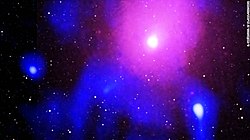| NeVe 1 | |
|---|---|
 Combined XMM-Newton and GMRT image of the Ophiuchus Cluster, with NeVe 1 being the bright, purple spot. The blue cloud on its lower left is the remnant of the eruption. | |
| Observation data (J2000 epoch) | |
| Constellation | Ophiuchus |
| Right ascension | 17h 12m 27.74s[1] |
| Declination | −23° 22′ 10.8″[1] |
| Redshift | 0.02846[1] |
| Heliocentric radial velocity | 8530.9 km/s[1] |
| Distance | 411.2 Mly (126.08 Mpc)[1] (comoving distance) |
| Group or cluster | Ophiuchus Cluster |
| Apparent magnitude (V) | not visible |
| Characteristics | |
| Type | E, cD[1] |
| Size | ~331,800 ly (101.74 kpc) (estimated) [1] |
| Notable features | Host galaxy of the Ophiuchus Supercluster eruption |
| Other designations | |
| WISEA J171227.81-232210.7; 2MASX J17122774-2322108; PGC 59827; Ophiuchus Cluster BCG; Ophiuchus A[1] | |
NeVe 1[2] is a supergiant elliptical galaxy, which is the central, dominant member and brightest cluster galaxy (BCG) of the Ophiuchus Cluster. It lies at a distance of about 411 million light-years away from Earth and is located behind the Zone of Avoidance region in the sky. It is the host galaxy of the Ophiuchus Supercluster eruption, the most energetic astronomical event known.[3][4][5]
- ^ a b c d e f g h "NASA/IPAC Extragalactic Database". Results for WISEA J171227.81-232210.7. Retrieved 2021-09-10.
- ^ "SIMBAD Astronomical Database". Results for 2MASX J17122774-2322108.
- ^ "Ophiuchus Galaxy Cluster". NASA. 27 February 2020. Retrieved 10 September 2021.
- ^ Overbye, Dennis (6 March 2020). "This Black Hole Blew a Hole in the Cosmos - The galaxy cluster Ophiuchus was doing just fine until WISEA J171227.81-232210.7—a black hole several billion times as massive as our sun — burped on it". The New York Times. Retrieved 30 September 2021.
- ^ "The AGN Outburst we won't call an explosion and a rock around the Earth | The Daily Space". 28 February 2020. Retrieved 2021-09-10.